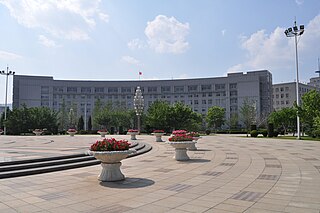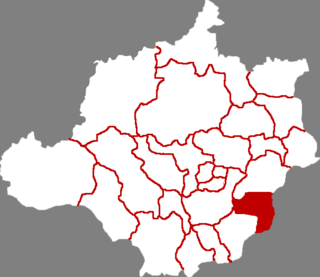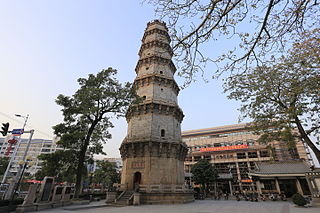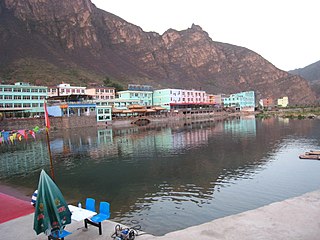
Zhoushan (help·info), formerly romanized as Chusan, is a prefecture-level "city" in northeastern Zhejiang Province in eastern China. It consists of an archipelago of islands at the southern mouth of Hangzhou Bay, off Ningbo. The prefecture's city proper is Dinghai on Zhoushan Island, now administered as the prefecture's Dinghai District. During the 2010 census, Zhoushan Prefecture's population was 1,121,261, out of whom 842,989 lived in the urban districts of Dinghai and Putuo.

Zhuanghe is one of the two "northern county-level cities", the other being Wafangdian, under the administration of Dalian, located in the south of Liaoning province, People's Republic of China. Its area is 3,655.70 square kilometres (1,411.47 sq mi) and its permanent population as of 2010 is 841,321, making it Dalian's most spacious county-level division.

Gaoyang County is a county in the central part of Hebei province, People's Republic of China. It is under the jurisdiction of the prefecture-level city of Baoding and has an area of 497 km2 (192 sq mi).

Chaoyang District is a district in the municipality of Shantou, Guangdong Province, China.

Fuding (help·info) is a county-level city in northeastern Ningde prefecture level city, on Fujian's border with Zhejiang province.
Chonghai Bridge is a bridge, located at 31.85°N 121.28°E, spanning the northern distributary of the Yangtze River in China that is currently under construction. The bridge, along with the Chongqi Bridge and the Shanghai Yangtze River Tunnel and Bridge will connect the city of Shanghai with the north bank of the Yangtze in Jiangsu Province via Chongming Island.

Haimen is a county-level city under the administration of Nantong, Jiangsu province, with a population of approximately 1 million. It is located at the opposite side of the Yangtze River to Shanghai and is directly north of Chongming Island except for a small portion that forms Haimen City's Haiyong Township. Haimen is the seat of the Roman Catholic Diocese of Haimen.

Jiaojiang District is a district and the seat of the prefecture-level city of Taizhou in Zhejiang Province, China. It is named after the Jiao River.

Fufeng County is a county under the administration of the prefecture-level city of Baoji, in the west-central part of Shaanxi Province, China. The county lies on the north bank of the Wei River between Xi'an, 110 km (68 mi) to the east, and Baoji, 95 km (59 mi) to the west. It has a land area of 751 km2 (290 sq mi), and a population of 460,000.

Laishui County is a county in central Hebei province, China, bordering the Municipality of Beijing to the north and in the basin of the Juma River. It is under the administration of the prefecture-level city of Baoding and contains its northernmost point; it has a population of 340,000 residing in an area of 1,666 km2 (643 sq mi). It is served by China National Highway 112 and G5 Beijing–Kunming Expressway.

Raoyang County is county in the southeast of Hebei province, China, served by G45 Daqing–Guangzhou Expressway. It is under the administration of the prefecture-level city of Hengshui, and, as of 2004, has a population of 290,000 residing in an area of 573 km2 (221 sq mi).

Haigang is a district of the coastal city of Qinhuangdao, Hebei province, People's Republic of China. The seat of the municipal government, as of 2004, it had a population of 550,000 residing in an area of 121 km2 (47 sq mi).

Caofeidian District, formerly Tanghai County, is a district of Tangshan, Hebei, People's Republic of China, along the coast of the Bohai Sea. As of 2003, it had a population of 140,000 residing in an area of 725 km2 (280 sq mi). The district's administration is highly unusual in that apart from its seat, Tanghai (唐海镇) and two other towns Binhai (滨海镇) and Liuzan (柳赞镇) the rest of its administrative units are informal, mostly being farms.

Shuangfeng County is a county in Hunan Province, China, it is under the administration of Loudi prefecture-level City.

Huinan County is a county of southwestern Jilin province, China. It is under the administration of Tonghua City, with a population of 350,000 residing in an area of 2,277 km2 (879 sq mi).
Jianghai garden is a cultural and natural ecologically friendly park. It lies in the south of Haimen Nantong, near the Yangtze River.

Hengyang Nanyue Airport is an airport serving the city of Hengyang in Hunan province, China. Located in Yunji Town, Hengnan County, the airport is named after Mount Heng, also known as Nanyue. It replaced the old Bajialing Airport, which was shut down in 1995. Construction of the airport started on 7 January 2012 with a total investment of 656 million yuan, and the airport was opened on 23 December 2014, with an inaugural flight from Beijing Nanyuan Airport.

The 2011 Haimen protest of December 2011 occurred in the Chinese town of Haimen, Guangdong province. The protests, which drew thousands of participants, were met with detentions and tear gassing by authorities.
The Port of Taizhou is a natural seaport on the coast of the prefectural-level city of Taizhou, Zhejiang Province, People's Republic of China. The Port is centered at the mouth of the Jiaojiang River, with port areas opening to the Taizhou Bay, Yueqing Bay and Sanmen Bay of the East China Sea. It is considered as the southernmost of the ports of the Yangtze Delta economic area. In 2013 it reached a throughput of 56.28 million metric tons, an increase of 5.0% over 2012, and a container throughput of 166,571 TEUs, an increase of 10.4%.
Haiyong, formerly Haiyong Township, is a town of Haimen in Jiangsu, China. Together with neighboring Qilong, it forms a pene-enclave of the province on Chongming Island, most of which belongs to the province-level municipality of Shanghai. Haiyong presently covers about 12.5 square kilometers (5 sq mi) and had a population of 5,004 during the year 2000 census.

















